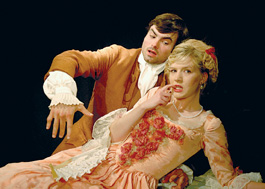home | metro silicon valley index | the arts | stage | review

Photograph by Katie Pfeiffer
Ryan's Hope: Chris Ryan lays siege to Sarah Moser in 'Restoration Comedy.'
Wanton Ways
Stanford Summer Theater stages Amy Freed's witty 'Restoration Comedy' pastiche
By Marianne Messina
THERE IS nothing like getting out of the century for a new lease on humor. And Amy Freed's play Restoration Comedy takes us to a period of hedonistic backlash following a Puritanical interregnum that had outlawed theater. Before assuming the role of Loveless, Leith Burke tells us that Stanford Summer Theater chose the Restoration period "so we can get to wear the clothes." Costume designer Connie Strayer has taken the 17th-century wardrobe—arguably the most outlandish in Western history—to the limit in this production: velvet frock coats, satin breeches and hose, wigs with waist-length ringlets, drapes of white ruffles pouring from monster cuffs, squash-heeled shoes decorated with buckles and plumes.
Taken from two Restoration plays, Freed's rakish hero, Loveless, associates the word "marriage" with a noose. So his virtuous—both loving and loyal—wife, Amanda (Jennifer Erdmann), sets out to win him back by becoming "all women." In a humorous scene, the man who truly (as truly as possible in the cynical Restoration) loves her instructs the "priggish" Amanda in the ways of the loose women her husband can't resist. Worthy (Joseph Rende) tells her that a wanton woman leans into and on things. "It suggests she might be easily toppled," he explains. Naturally, teaching her too well results in the teacher "losing his head" for the student.
Freed maintains the Restoration emphasis on style and wit. It was either have wit or have wit turned upon you. The witless but well-dowered Narcissa is on the butt end of Worthy's wit. "My heat is for her bank account it's true," he confesses to the audience. "Dost love me for my mind?" the oblivious Narcissa (Sarah Moser) asks him. "I cannot bear the pain of further conversation," he replies.
Freed takes advantage of internal and external wit. The reformed Loveless of Act 2 comments on the reformed character in a play: "He's just like me with the addition of a relapse in the second act," an inside nod to John Vanbrugh's The Relapse, on which this play is partly based. And the wit takes a postmodern leap out of the play as Loveless scours the stage for a place to hide and complains "damned these minimalist sets!"
Burke gives us a commanding Loveless—his confidential asides feel clever in their candidness. He's the exciting friend you don't trust. Erdmann's Amanda is suitably upright in her Puritan black dress, yet warm enough to have desires and be Restoration frank about them. But in this play, parts can be overacted almost with impunity. Extremely overdone, Moser's Narcissa is yet as charming as she is empty-headed. Rende's stentorian Worthy mocks the heroic ideal. The stage lights up in more ways than one whenever Jeffrey Bihr's Sir Novelty Fashion arrives. As the "what not to do" of fashion, Sir Novelty first appears in grab-your-sunglasses yellow, his face dotted with faux moles as he refuses his younger brother any part of the family fortune. Later, dressed to visit his wealthy hoped-for bride, his costume hits a new peak: vertigo-pink frock coat over a pair of lavender silk breeches and an expansive white wig the size of an alpaca. Bihr is one of those actors who breathe their character from every pore; you won't detect him shifting in and out of gears between speaking parts.
Also, behind the scenes, Bihr has created a sound design Baroque enough to call up the period and contemporary enough to appropriate the play for our times. Including some S/M bits, a harpsichord version of "Dueling Banjos" and bawdiness refreshing in its antiquity, this production is sharp as a rake.
Restoration Comedy, a Stanford Summer Theater production, plays Thursday-Sunday at 8pm through Aug. 13 at Pigott Theater, Memorial Auditorium, Stanford University. Admission is pay what you like. (650.725.5838)
Send a letter to the editor about this story.
|
|
|
|
|
|